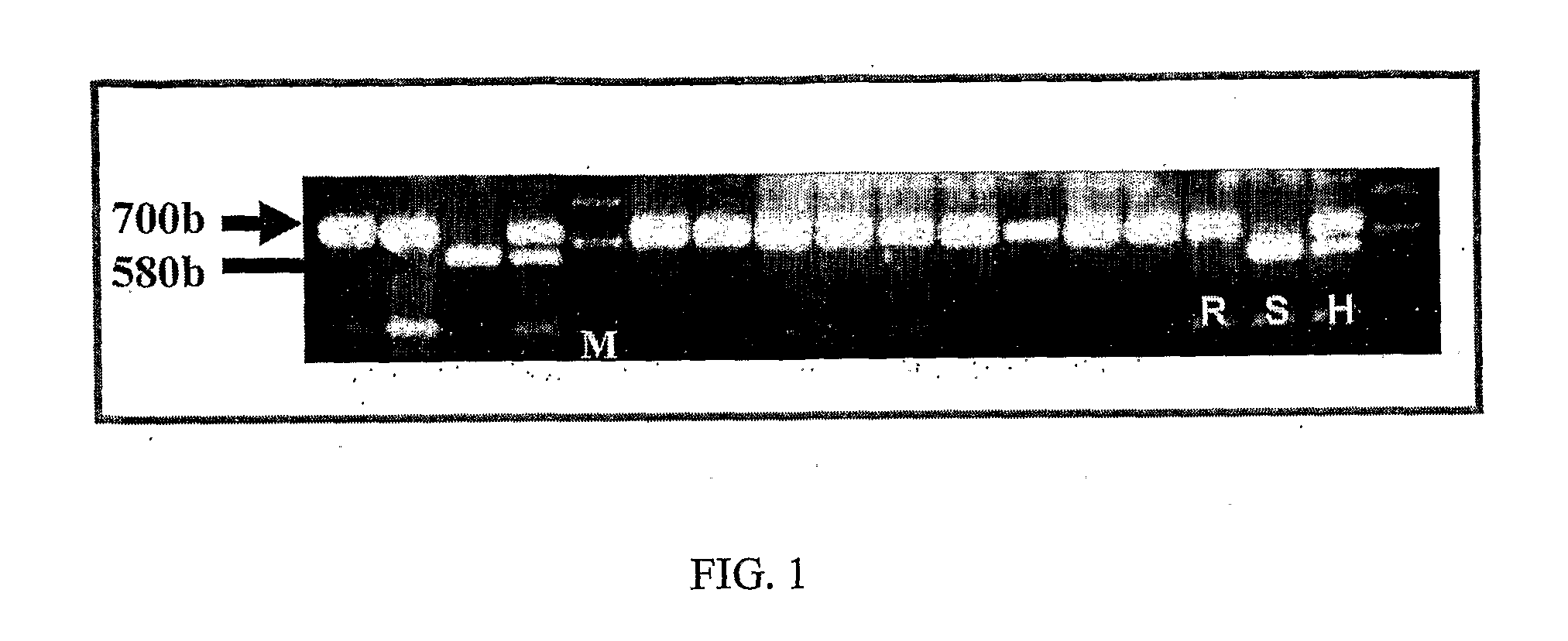Disease Resistant Pepper Plants
a pepper plant, disease-resistant technology, applied in the field of pepper plants, can solve the problems of limiting the efficiency of chemical fungicides, affecting the survival rate of pepper plants, and affecting the viability of plant viruses,
- Summary
- Abstract
- Description
- Claims
- Application Information
AI Technical Summary
Benefits of technology
Problems solved by technology
Method used
Image
Examples
example 1
Evaluation of Resistance Using Biological Assays
[0156]1. Evaluation of Resistance to Infection by the Fungus L. taurica.
[0157]Powdery mildew disease is caused by the fungus Leveillula taurica. This fungus is an obligatory parasite, i.e. it can propagate only on living plants. The fungus infects the plant leaves only. Typically, the older (lower) leaves of the plant are infected first, and then the fungus spread to the upper part of the plant to young leaves. Examination of plants for susceptibility / resistance to L. taurica was performed according to the procedure described below.
Inoculum's Preparation
[0158]As indicated above, the fungus L. taurica must be propagated on a living plant material. Thus, an inuculm is kept by infecting susceptible pepper plants in a two-week cycle. In each cycle, 10-20 containers of 1-liter each containing one susceptible pepper seedling (Hazera Genetic internal varieties T-52, L-3 and L-4) are inoculated with spores from infected leaves by air-dispersi...
example 2
Evaluation of resistance using genetic tools
DNA Isolation
Solutions:
Extraction Buffer:
[0170]
Sorbitol0.35MTris-base0.1MEDTA5 mM
[0171]pH adjusted to 7.5 with concentrated HCl.
Nuclear Lysis Buffer:
10 ml of 0.5M EDTA pH 8.0
40 ml of 5.0M NaCl
2 gr CTAB
[0172]The solution is stirred overnight and the pH is adjusted to 7.5 with concentrated HCl. The solution is then diluted with distilled water to total volume of 90 ml.
Sarcosyl Solution:
5% N-lauroylsarcosine
TE Solution
10 mM Tris-HCl pH 8.0
1 mM EDTA
Storage Buffer
80 ml of 95% Ethanol
20 ml of 1M Na-acetate
[0173]pH is adjusted to 7.5 with concentrated HCl.
Octanol / Chloroform Solution (1:24)
[0174]One volume of octanol is mixed with 24 volumes of chloroform.
DNA Extraction Procedure
[0175]Total DNA was extracted from fresh plant tissue (leaf, green fruit, seedlings) using the following procedure:[0176]1. Fresh extraction solution is prepared by mixing 20 ml of Extraction Buffer, 20 ml of Nuclear Lysis Buffer and 8 ml of Sarcosyl solution. 0.38 mg of S...
example 3
Production of Pepper Plants Having PM Resistance Allele and PVY Resistance Allele in Cis Configuration on the Same Chromosome
[0192]The source material included: pepper inbred line 50-0259A-4 that is resistant to powdery mildew (PM) and susceptible to PVY; and pepper inbred line 100 / 201C that is susceptible to PM and resistant to PVY. These inbred lines were crossed to produce F2 population. The F2 population (122 plants) plus the resistant and susceptible parents and F1 progeny were planted in a greenhouse in The Volcani Center (Bet Dagan, Israel) during the winter of 2005 / 06. Plants were identified as resistant or susceptible to PM infection by L. taurica as described hereinabove. Infection and pathology evaluation was carried out twice at the stage of mature ripe fruit. The resistant parent, homozygous for PM-resistance allele did not develop any symptoms, the susceptible parent had high occurrence of fungus while plants of F1 progeny were moderately resistant with low level of fu...
PUM
| Property | Measurement | Unit |
|---|---|---|
| temperature | aaaaa | aaaaa |
| temperature | aaaaa | aaaaa |
| time | aaaaa | aaaaa |
Abstract
Description
Claims
Application Information
 Login to View More
Login to View More - R&D
- Intellectual Property
- Life Sciences
- Materials
- Tech Scout
- Unparalleled Data Quality
- Higher Quality Content
- 60% Fewer Hallucinations
Browse by: Latest US Patents, China's latest patents, Technical Efficacy Thesaurus, Application Domain, Technology Topic, Popular Technical Reports.
© 2025 PatSnap. All rights reserved.Legal|Privacy policy|Modern Slavery Act Transparency Statement|Sitemap|About US| Contact US: help@patsnap.com



